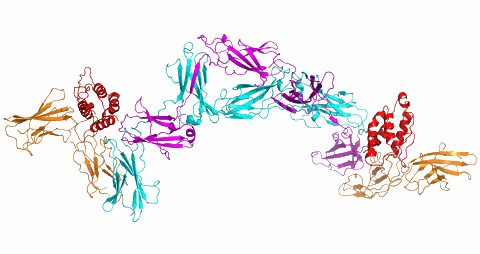Scientists using an x-ray beamline at the U.S. Department of Energy’s Advanced Photon Source (APS) at Argonne National Laboratory have unraveled the structure of a cell-signaling receptor in the blood control system that, when damaged, is responsible for diseases, including certain types of leukemia and some inflammatory diseases such as rheumatoid arthritis and asthma. This discovery helps to explain for the first time, how this receptor is activated, and could form a springboard for the development of new treatments.
The findings, published in the journal Cell, are the result of a collaboration among Australian scientists from St Vincent’s Institute, Melbourne, and the Hanson Institute at the Institute of Medical and Veterinary Science, Adelaide.
Using x-ray crystallography at BioCARS beamline 14-BM-C at the APS, the researchers determined the first three-dimensional image of the receptor’s structure and will use that unique knowledge in pursuit of drugs to modify the receptor’s action and thus control diseases such as leukemia and asthma.
“Leukemia is a type of cancer where an excessive number of malfunctioning white blood cells are produced,” said co-author Angel Lopez of the Hanson Institute. “We have established the structure of a receptor that controls the actions of a blood-forming regulator called granulocyte-macrophage colony-stimulating factor, or GM-CSF.
“GM-CSF has been of interest to researchers and clinicians for many years now because its ‘controller’ or ‘receptor,’ found on the surface of blood cells, is critical in regulating their many functions. In leukemia, some of the signals coming from the receptor are abnormal, causing the blood cells to grow uncontrollably, malfunction, or dangerously persist past their use-by date.”
Co-author Michael Parker of St Vincent’s Institute said, “Because our discovery shows precisely what the receptor looks like and also how it works, we can now begin to design new drugs to rein in the deadly abnormal blood cells. At the moment, many forms of leukemia are treated with chemotherapy that destroys the diseased blood cells and bone marrow as well as normal cells. We hope that this discovery will lead to targeted therapies, more specific to the malfunctioning cells seen in diseases such as leukemia.
“To maximize the drug development opportunities of this discovery, both institutes have recently signed an agreement with biopharmaceutical company CSL Limited. Under the agreement, the institutes will work with CSL to discover and develop new therapeutic antibodies.”
Contact: angel.lopez@imvs.sa.gov.au, mparker@svi.edu.au
See: Guido Hansen, Timothy R. Hercus, Barbara J. McClure, Frank C. Stomski, Mara Dottore, Jason Powell, Hayley Ramshaw, Joanna M. Woodcock, Yibin Xu, Mark Guthridge, William J. McKinstry, Angel F. Lopez, and Michael W. Parker, “The Structure of the GM-CSF Receptor Complex Reveals a Distinct Mode of Cytokine Receptor Activation,” Cell 134, 496 (08 August 2008). DOI:10.1016/j.cell.2008.05.053

